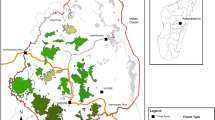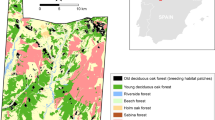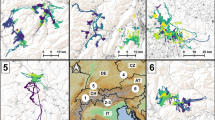Abstract
Context
Theory predicts that movement limitation due to landscape fragmentation can reduce population viability. Understanding how landscape heterogeneity influences movement is thus critical for testing theory and developing conservation strategies. Consequently, studies are needed that link movement data with landscape features influencing dispersal.
Objectives
We used experimental translocations to test whether forest fragmentation constrains movements of two fragmentation-sensitive bird species. We also tested for evidence of multiple behavioral movement phases (i.e., exploring, homing) and evaluated whether fragmentation effects varied between them.
Methods
Over two breeding seasons we translocated territorial Wood Thrushes (Hylocichla mustelina; n = 36) and Ovenbirds (Seiurus aurocapilla; n = 19) 1–1.2 km across landscapes spanning a fragmentation gradient and recorded spatial (movement path) and temporal (return time) homing data using VHF transmitters and receivers.
Results
Ninety-one percent of individuals returned home, taking up to 72.2 h. Movements of 98% of returning birds indicated distinct exploring (i.e., short, undirected movements and course reversals) and homing (i.e., large, fast steps towards home) movement phases. Both species chose steps minimizing gap exposure in both phases. However, landscape fragmentation had no negative effect on homing times or path straightness.
Conclusions
Our results suggest movement limitation does not drive fragmentation sensitivity in these species. Discrepancy between step- and path-level analyses either indicate that fine-scale movement data do not reflect landscape connectivity, or that artificially motivated animals respond unnaturally to behavioral barriers. Given evidence for dichotomous movement behavior, future studies linking these behaviors to life stages will elucidate when and how landscape features influence movement.




Similar content being viewed by others
Data availability
All data collected and analyzed during this study are included in Online Resources 3–6.
References
Anders AD, Faaborg J, Thompson FR (1998) Postfledging dispersal, habitat use, and home-range size of juvenile Wood Thrushes. Auk 115:349–358
Andrén H (1994) Effects of habitat fragmentation on birds and mammals in landscapes with different proportions of suitable habitat: a review. Oikos 71:355–366
Baguette M, Van Dyck H (2007) Landscape connectivity and animal behavior: functional grain as a key determinant for dispersal. Landscape Ecol 22:1117–1129
Bayne EM, Hobson KA (2001) Movement patterns of adult male ovenbirds during the post-fledging period in fragmented and forested boreal landscapes. Condor 103:343–351
Beier P, Noss RF (1998) Do habitat corridors provide connectivity? Conserv Biol 12:1241–1252
Bélisle M (2005) Measuring landscape connectivity: the challenge of behavioral landscape ecology. Ecology 86:1988–1995
Bélisle M, Desrochers A (2002) Gap-crossing decisions by forest birds: an empirical basis for parameterizing spatially-explicit, individual-based models. Landscape Ecol 17:219–231
Bélisle M, Desrochers A, Fortin M-J (2001) Influence of forest cover on the movements of forest birds: a homing experiment. Ecology 82:1893–1904
Bélisle M, St. Clair CC (2001) Cumulative effects of barriers on movements of forest birds. Conserv Ecol 5:9
Betts MG, Gutzwiller KJ, Smith MJ, Robinson WD, Hadley AS (2015) Improving inferences about functional connectivity from animal translocation experiments. Landscape Ecol 30:585–593
Betts MG, Hadley AS, Rodenhouse N, Nocera JJ (2008) Social information trumps vegetation structure in breeding-site selection by a migrant songbird. Proc R Soc B 275:2257–2263
Biz M, Cornelius C, Metzger JPW (2017) Matrix type affects movement behavior of a Neotropical understory bird. Perspect Ecol Conserv 15:10–17
Butler H, Malone B, Clemann N (2005) The effects of translocation on the spatial ecology of tiger snakes (Notechis scutatus) in a suburban Landscape. Wildl Res 32:165–171
Castellón TD, Sieving KE (2006) An experimental test of matrix permeability and corridor use by an endemic understory bird. Conserv Biol 20:135–145
Desrochers A, Bélisle M, Morand-Ferron J, Bourque J (2011) Integrating GIS and homing experiments to study avian movement costs. Landscape Ecol 26:47–58
Desrochers A, Hannon SJ (1997) Gap crossing decisions by forest songbirds during the post-fledging period. Conserv Biol 11:1204–1210
Desrochers A, Hannon SJ, Bélisle M, St. Clair CC (1999) Movement of songbirds in fragmented forests: can we ‘scale up’ from behavior to explain occupancy patterns in the landscape? In: Adams NJ, Slotow RH (eds) Proceedings of the 22nd International Ornithological Congress, Durban, pp 2447–2464
Duchesne T, Fortin D, Courbin N (2010) Mixed conditional logistic regression for habitat selection studies. J Anim Ecol 79:548–555
Fahrig L (2003) Effects of habitat fragmentation on biodiversity. Annu Rev Ecol Evol Syst 34:487–515
Fahrig L (2013) Rething patch size and isolation effects: the habitat amount hypothesis. J Biogeogr 40:1649–1663
Fahrig L, Merriam G (1985) Habitat patch connectivity and population survival. Ecology 66:1762–1768
Fletcher RJ, Maxwell CW, Andrews JE, Helmey-Hartman WL (2013) Signal detection theory clarifies the concept of perceptual range and its relevance to landscape connectivity. Landscape Ecol 28:57–67
Fletcher RJ, Ries L, Battin J, Chalfoun AD (2007) The role of habitat area and edge in fragmented landscapes: definitievely distinct or inevitably intertwined? Can J Zool 85:1017–1030
Fortin D, Beyer HL, Boyce MS, Smith DW, Duchesne T, Mao JS (2005) Wolves influence elk movements: behavior shapes a trophic cascade in Yellowstone National Park. Ecology 86:1320–1330
Getz WM, Saltz D (2008) A framework for generating and analyzing movement paths on ecological landscapes. Proc Natl Acad Sci 105:19066–19071
Gillies CS, Beyer HL, St. Clair CC (2011) Fine-scale movement decisions of tropical forest birds in a fragmented landscape. Ecol Appl 21:944–954
Gillies CS, St. Clair CC (2008) Riparian corridors enhance movement of a forest specialist bird in fragmented tropical forest. Proc Natl Acad Sci 105:19774–19779
Gobeil J-F, Villard M-A (2002) Permeability of three boreal forest landscape types to bird movements as determined from experimental translocations. Oikos 98:447–458
Groom JD, Grubb TC (2006) Patch colonization dynamics in Carolina Chickadees (Poecile carolinensis) in a fragmented landscape: a manipulative study. Auk 123:1149–1160
Gurarie E (2014) bcpa: Behavioral change point analysis of animal movement. R package version 1.1. https://CRAN.R-project.org/package=bcpa
Gurarie E, Andrews RD, Laidre KL (2009) A novel method for identifying behavioural changes in animal movement data. Ecol Lett 12:395–408
Haddad NM, Brudvig LA, Clobert J, Davies KF, Gonzalez A, Holt RD, Lovejoy TE, Sexton JO, Austin MP, Collins CD, Cook WM, Damschen EI, Ewers RM, Foster BL, Jenkins CN, King AJ, Laurance WF, Levey DJ, Margueles CR, Melbourne BA, Nicholls AO, Orrock JL, Song D-X, Townshend JR (2015) Habitat fragmentation and its lasting impact on Earth’s ecosystems. Sci Adv 1:e1500052
Hadley AS, Betts MG (2009) Tropical deforestation alters hummingbird movement patterns. Biol Lett 5:207–210
Hanski I (1998) Metapopulation dynamics. Nature 396:41–49
Harris RJ, Reed JM (2002) Behavioral barriers to non-migratory movements of birds. Annu Zool Fenn 39:275–290
Heidinger IMM, Poethke H-J, Bonte D, Hein S (2009) The effect of translocation on movement behavior—a test of the assumptions of behavioural studies. Behav Process 82:12–17
Hobson KA, Wassenaar LI, Bayne E (2004) Using isotopic variance to detect long-distance dispersal and philopatry in birds: an example with Ovenbirds and American Redstarts. Condor 106:732–743
Kennedy CM, Marra PP (2010) Matrix mediates avian movements in tropical forested landscapes: Inference from experimental translocations. Biol Conserv 143:2136–2145
Kesler DC, Cox AS, Albar G, Gouni A, Mejeur J, Plassé C (2012) Translocation of Tuamotu Kingfishers, postrelease exploratory behavior, and harvest effects on the donor population. Pac Sci 66:467–480
Lima SL, Zollner PA (1996) Towards a behavioral ecology of ecological landscapes. Trends Ecol Evol 11:131–135
Lynch JF, Whigham DF (1984) Effects of forest fragmentation on breeding bird communities in Maryland, USA. Biol Conserv 28:287–324
MacIntosh T, Stutchbury BJM, Evans ML (2011) Gap-crossing by Wood Thrushes (Hylocichla mustelina) in a fragmented landscape. Can J Zool 89:1091–1097
Moilanen A, Hanski I (2001) On the use of connectivity measures in spatial ecology. Oikos 95:147–151
Morales JM, Ellner SP (2002) Scaling up animal movements in heterogeneous landscapes: the importance of behavior. Ecology 83:2240–2247
Nathan R, Getz WM, Revilla E, Holyoak M, Kadmon R, Saltz D, Smouse PE (2008) A movement ecology paradigm for unifying organismal Movement. Proc Natl Acad Sci 105:19052–19059
Nocera JJ, Forbes GJ, Giraldeau L-A (2006) Inadvertent social information in breeding site selection of natal dispersing birds. Proc R Soc B 273:349–355
Pardini R, Bueno ADA, Gardner TA, Prado PI, Metzger JP (2010) Beyond the fragmentation threshold hypothesis: regime shifts in biodiversity across fragmented landscapes. PLoS ONE 5:e13666
Pinheiro J, Bates D, DebRoy S, Sarkar D, R Core Team (2017) nlme: Linear and Nonlinear Mixed Models. R package version 3.1-131. https://CRAN.R-project.org/package=nlme
Rands MRW, Adams WM, Bennun L, Butchart SHM, Clements A, Coomes D, Entwistle A, Hodge I, Kapos V, Scharlemann JPW, Sutherland WJ, Vira B (2010) Biodiversity conservation: challenges beyond 2010. Science 329:1298–1303
Rappole JH, Tipton AR (1991) New harness design for attachment of radio transmitters to small passerines. J Field Ornithol 62:335–337
Reinert HK, Rupert RR (1999) Impacts of translocation on behavior and survival of Timber Rattlesnakes, Crotalus horridus. J Herpetol 33:45–61
Ricketts TH (2001) The matrix matters: effective isolation in fragmented landscapes. Am Nat 158:87–99
Ries L, Fletcher RJ, Battin J, Sisk TD (2004) Ecological responses to habitat edges: mechanisms, models, and variability explained. Annu Rev Ecol Evol Syst 35:491–522
Robbins CS, Dawson DK, Dowell BA (1989) Habitat area requirements of breeding forest birds of the Middle Atlantic states. Wildl Monogr 103:3–34
Sarrias M, Daziano RA (2017) Multinomial logit models with continuous and discrete individual heterogeneity in R: the gmnl package. J Stat Softw. https://doi.org/10.18637/jss.v079.i02
Selonen V, Hanski IK, Desrochers A (2010) Measuring habitat availability for dispersing animals. Landscape Ecol 25:331–335
Smith MJ, Betts MG, Forbes GJ, Kehler DG, Bourgeois MC, Flemming SP (2011) Independent effects of connectivity predict homing success by northern flying squirrel in a forest mosaic. Landscape Ecol 26:709–721
St. Clair CC (2003) Comparative permeability of roads, rivers, and meadows to songbirds in Banff National Park. Conserv Biol 17:1151–1160
St. Clair CC, Bélisle M, Desrochers A, Hannon S (1998) Winter responses of forest birds to habitat corridors and gaps. Conserv Ecol 2:13
Taylor PD, Fahrig L, Henein K, Merriam G (1993) Connectivity is a vital element of landscape structure. Oikos 68:571–573
Tischendorf L, Fahrig L (2000) On the usage and measurement of landscape connectivity. Oikos 90:7–19
Tischendorf L, Fahrig L (2001) On the use of connectivity measures in spatial ecology. A reply. Oikos 95:152–155
Tittler R, Fahrig L, Villard M-A (2006) Evidence of large-scale source-sink dynamics and long-distance dispersal among Wood Thrush populations. Ecology 87:3029–3036
Tremblay MA, St. Clair CC (2011) Permeability of a heterogeneous urban landscape to the movements of forest songbirds. J Appl Ecol 48:679–688
Tsoar A, Nathan R, Bartan Y, Vyssotski A, Dell’Omo G, Ulanovsky N (2011) Large-scale navigational map in a mammal. Proc Natl Acad Sci 10:E718–E724
Turgeon K, Robillard A, Gregoire J, Duclos V, Kramer DL (2010) Functional connectivity from a reef fish perspective: behavioral tactics for moving in a fragmented landscape. Ecol 91:3332–3342
Valente JJ, Betts MG (2019) Response to fragmentation by avian communities is mediated by species traits. Divers Distrib 25:48–60
Vasudev D, Fletcher RJ (2015) Incorporating movement behavior into conservation prioritization in fragmented landscapes: an example of western hoolock gibbons in Garo Hills, India. Biol Conserv 181:124–132
Vasudev D, Fletcher RJ, Goswami VR, Krishnadas M (2015) From dispersal constraints to landscape connectivity: lessons from species distribution modeling. Ecography 38:967–978
Vega Rivera JH, McShea WJ, Rappole JH, Haas CA (1999) Postbreeding movements and habitat use of adult Wood Thrushes in northern Virginia. Auk 116:458–466
Vega Rivera JH, Rappole JH, McShea WJ, Haas CA (1998) Wood Thrush postfledging movements and habitat use in northern Virginia. Condor 100:69–78
Villard M-A, Merriam G (1995) Dynamics in subdivided populations of neotropical migratory birds in a fragmented temperate forest. Ecol 76:27–40
Villard M-A, Trzcinski MK, Merriam G (1999) Fragmentation effects on forest birds: relative influence of woodland cover and configuration on landscape occupancy. Conserv Biol 13:774–783
Vitz AC, Rodewald AD (2010) Movements of fledgling Ovenbirds (Seiurus aurocapilla) and Worm-eating Warblers (Helmitheros vermivorum) within and beyond the natal home range. Auk 127:364–371
Volpe NL, Hadley AS, Robinson WD, Betts MG (2014) Functional connectivity experiments reflect routine movement behavior of a tropical hummingbird species. Ecol Appl 24:2122–2131
Zeller KA, McGarigal K, Whiteley AR (2012) Estimating landscape resistance to movement: a review. Landscape Ecol 27:777–797
Acknowledgements
This research was funded by the U.S. Army Engineer Research and Development Center Environmental Quality and Installations 6270/896/04 (PE/Project/Task). We thank the Department of Defense Strategic Environmental Research and Development Program (grant RC-2121) for helping to facilitate this work. We also thank M. Bélisle and two anonymous reviewers for their constructive feedback which greatly improved the manuscript.
Author information
Authors and Affiliations
Corresponding author
Ethics declarations
Conflict of interest
The authors declare that they have no conflict of interest.
Additional information
Publisher's Note
Springer Nature remains neutral with regard to jurisdictional claims in published maps and institutional affiliations.
Electronic supplementary material
Below is the link to the electronic supplementary material.
Rights and permissions
About this article
Cite this article
Valente, J.J., Fischer, R.A., Ryder, T.B. et al. Forest fragmentation affects step choices, but not homing paths of fragmentation-sensitive birds in multiple behavioral states. Landscape Ecol 34, 373–388 (2019). https://doi.org/10.1007/s10980-019-00777-z
Received:
Accepted:
Published:
Issue Date:
DOI: https://doi.org/10.1007/s10980-019-00777-z




